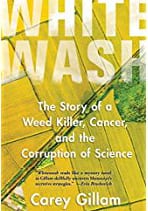 Written by Carey Gillam
Written by Carey Gillam
Published by Island Press, October 2017
Reviewed by Kerry O’Kelly
Is the EPA actually working to protect the public from the potential dangers of Roundup®?
Carey Gillam makes a strong case for answering that question with a “NO.”
Whitewash is a detailed examination of the tactics Monsanto uses to keep control of the glyphosate narrative despite growing data and activism against the weed killer. Gillam contends, and backs up with ample, detailed evidence obtained through the Freedom of Information Act and the discovery process from active lawsuits, that Monsanto has undue influence among regulatory agencies, primarily the Environmental Protection Agency (EPA), and is using all its substantial resources to suppress any question of glyphosate’s safety for humans or the environment. This book is very timely and thorough, but it is not for the beginner as it reads more like a research paper than a narrative and could have benefited from some graphics to bring some clarity to the dense information.
It is a story of a “big money” industry using its power to create a positive perception of glyphosate through:
- Sponsoring “independent” industry organizations to promote their products and to influence legislation and regulation
- Placing former employees in key positions at regulatory agencies (the EPA) and giving them specific directions on how to act on policies
- Influencing EPA employees and scientists to support their view of products and feeding them direct quotes to use in statements
- Claiming all the research that proves glyphosate is safe is a “Trade Secret” so it cannot be evaluated by any independent scientists
- Actively seeking to discredit any research Monsanto has not approved
- Refusing to test actual formulations of herbicides which, many suspect, may be more toxic than glyphosate alone
- Preventing adequate residue testing and application monitoring
- Creating circular arguments about exposure levels, i.e., no need to test to check if exposure levels are within set limits because it is safe
- Creating sham organizations to hamper activists both in person and on social media
Although the book does delve into some (but not all) of the potential and documented side effects of glyphosate use (cancer, super weeds, monarch decline, soil microbe disruption, etc.), there is no smoking gun pointing to any definite conclusions on the side effects. What it does point out is that there are many serious and valid questions about the use of glyphosate and its formulations which are not being addressed.
The stakes are huge. Glyphosate, in its many formulations, is the most commonly used agrochemical in the world and its use is growing:
- It is being used in significantly larger quantities on established farms due to weed resistance
- New formulations, which use ingredients from Agent Orange, are being developed to target new markets
- It is being peddled to more farmers worldwide than ever before
- It is being used on a wider variety of crops, including non-Roundup Ready crops, to simplify harvesting
At the same time, private testing is showing that glyphosate is being found in unexpected areas such as in honey and in human urine and at much higher levels than expected. Unfortunately, no government agency is tracking this information, so how much actual exposure the public is subjected to is unknown.
The questions this book raises could not be timelier as there is currently an effort by some U.S. Congressmen to pressure the World Health Organization cancer research program into recanting the designation of glyphosate as a “potential human carcinogen” by pulling their funding.
Carey Gillam has provided a detailed assessment of how our government is failing to protect the public from a multifaceted threat. Her book may be too detailed for a general audience, but her message warrants attention and action.
About the Reviewer
Kerry O’Kelly is a Certified Landscape Designer, an Accredited Organic Land Care Professional and Owner of Garden Dance Landscape Design in Andover, MA. She has been involved in the ELA community for many years and is currently serving as an ELA Board Member and participates in several committees. She can be reached by email at Kerry@GardenDanceLandscape.com.
***
Each author appearing herein retains original copyright. Right to reproduce or disseminate all material herein, including to Columbia University Library’s CAUSEWAY Project, is otherwise reserved by ELA. Please contact ELA for permission to reprint.
Mention of products is not intended to constitute endorsement. Opinions expressed in this newsletter article do not necessarily represent those of ELA’s directors, staff, or members.


